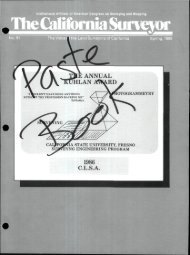The Summer of Living Dangerously (But Safely) - California Land ...
The Summer of Living Dangerously (But Safely) - California Land ...
The Summer of Living Dangerously (But Safely) - California Land ...
You also want an ePaper? Increase the reach of your titles
YUMPU automatically turns print PDFs into web optimized ePapers that Google loves.
Last summer my 19-year-old son, Conor, erstwhile college<br />
student (but mostly aspiring college baseball pitcher), came<br />
home needing a summer job. I gave him one and it turned out<br />
to be an interesting summer indeed. Buried in the following<br />
passages is a list <strong>of</strong> reasons why my wife is angry with me and<br />
why my other two sons may not end up getting all that much<br />
exposure to our exciting and soul-satisfying pr<strong>of</strong>ession.<br />
A few years back I heard the distant rumble <strong>of</strong> the impending<br />
collapse <strong>of</strong> the housing market and decided it was time to<br />
flee the Sacramento area and my position as survey manager<br />
for a multi-discipline firm. I had been primarily doing boundary<br />
surveys and supervising subdivision mapping for the previous<br />
fifteen years. <strong>The</strong> once red hot land development segment<br />
seemed to be cooling down rapidly and for some time I had<br />
been keeping my eye on my old home town in Northern<br />
Nevada, an area that ranks fourth in the world for gold production<br />
and produces significant amounts <strong>of</strong> other minerals,<br />
and precious and non-precious metals as well. As the longdepressed<br />
price <strong>of</strong> gold started to climb in 2004-2005 I made<br />
the decision to go home and hang my shingle, <strong>of</strong>fering surveying<br />
services to the mining community at large.<br />
Four years on it has turned out to be a very good move for<br />
me and I do not regret it in the least but I must say that there<br />
were necessarily some pr<strong>of</strong>ound changes in my day to day<br />
work routine, the most significant <strong>of</strong> which is that I spend<br />
probably 85% <strong>of</strong> my time in the field now and have been reintroduced<br />
in a major way to the concept <strong>of</strong> workplace safety. It<br />
seems funny using the term ‘workplace’ because in the course<br />
<strong>of</strong> a week, my workplace can be the muddy surface <strong>of</strong> a tails<br />
dam, the precipitous top <strong>of</strong> a mine high wall, the Jon-boat in<br />
which I perform somewhat primitive hydrographic surveys <strong>of</strong><br />
tails facilities and the mountains and deserts <strong>of</strong> the Great<br />
Basin. For me there is much to enjoy about my new pr<strong>of</strong>essional<br />
focus. However, there are many dangers concomitant<br />
with this line <strong>of</strong> work. I have gotten used to most <strong>of</strong> these dangers<br />
and I don’t much worry about them while going about my<br />
day but the key is to stay alert all the time. I focus on maintaining<br />
a rigorous safety regimen that can minimize these dangers.<br />
26<br />
By: Carl C. de Baca, PLS<br />
Carl C.de Baca is the owner <strong>of</strong> Alidade, Inc.,<br />
Elko, Nevada. He is a past editor <strong>of</strong> the <strong>California</strong><br />
Surveyor, and is the current NSPS Area 9 Director.<br />
<strong>The</strong> <strong>Summer</strong> <strong>of</strong> <strong>Living</strong><br />
<strong>Dangerously</strong> (<strong>But</strong> <strong>Safely</strong>)<br />
Thoughts on the concept <strong>of</strong> safety in the field.<br />
Mining is a dangerous business whether below ground or<br />
on the surface. A typical open pit gold mine has enormous<br />
machinery both stationary and mobile; steep and sometimes<br />
unstable slopes; explosives and explosions; poisonous, caustic<br />
and flammable liquids and gasses; and seemingly limitless<br />
opportunities to get hurt or killed. Over the last hundred and<br />
fifty years, many hundreds <strong>of</strong> miners have lost their lives in<br />
gruesome accidents throughout the country and the Mine<br />
Safety and Health Administration (MSHA) was created and still<br />
exists to prevent these accidents. MSHA requires that all new<br />
miners take a 24-hour introductory course in mine safety<br />
before going to work at a mine. This requirement also applies<br />
to contractors and consultants, such as me. MSHA also<br />
requires an annual 8 hour refresher course be taken so as to<br />
reinforce the importance <strong>of</strong> mine workplace safety. In addition<br />
to these safety courses, each mine also requires that site-specific<br />
safety training be administered to all miners at each mine<br />
and every task such as operating heavy equipment or working<br />
in the mill, requires specific task training as well. Each <strong>of</strong> these<br />
comes with a special U.S. Government Printing Office form<br />
called the 5000-23 that must be filled out and signed by both<br />
the trainer and the trainee and which must be renewed annually.<br />
<strong>The</strong> miner must keep these on his person at all times when<br />
on site. I have projects at several different mines which means<br />
I keep a binder <strong>of</strong> 5000-23’s in the truck and I must make sure<br />
not to let any <strong>of</strong> them expire. No one should ever operate<br />
equipment or work in hazardous places unless they have been<br />
properly trained. That alone eliminates many opportunities for<br />
accidents.<br />
After Conor completed his MSHA new miner training this<br />
June, I took him to his first mine: Newmont Mining<br />
Corporation’s Phoenix Mine located near Battle Mountain,<br />
Nevada. This mine has a sterling safety record and the people<br />
who work there are very focused on keeping it that way. As<br />
soon as you cross through the gates you must remember to<br />
turn on your headlights, turn on your strobe light, put up your<br />
fluorescent flag mast and most importantly to switch over to<br />
left-hand traffic. (This is routine at all surface mining operations<br />
due to the visual limitations <strong>of</strong> the large haul trucks.) At the<br />
Continued on next page<br />
www.californiasurveyors.org

















